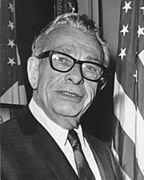United States Senate election in Delaware, 1966
United States Senate elections, 1966

|
|
|
33 of the 100 seats in the United States Senate,
plus 2 mid-term vacancies
51 seats needed for a majority
|
|
|

Results (including special elections)
Democratic gain Republican gain
Democratic hold Republican hold
|
|
U.S. Senate election in Illinois, 1966

|
|
|
|
|
|
U.S. Senate election in Massachusetts, 1966

|
|
|
|
|
|
U.S. Senate election in Montana, 1966

|
|
|
|
|
|
U.S. Senate election in Oregon, 1966

|
|
|
|
|
|
U.S. Senate election in South Carolina, 1966

|
|
|
|
|
|
U.S. Senate election in Virginia, 1966

|
|
|
|
|
|
U.S. Senate special election in Virginia, 1966

|
|
|
|
|
|
Mike Mansfield
Democratic
Mike Mansfield
Democratic
The United States Senate elections, 1966 was an election on November 8, 1966 for the United States Senate which occurred midway through the second (only full) term of President Lyndon B. Johnson. With divisions in the Democratic base over the Vietnam War, and with the traditional mid-term advantage of the party not holding the presidency, the Republicans took three Democratic seats. Despite Republican gains, the balance remained overwhelmingly in favor of the Democrats, who retained a 64–36 majority. This was also the first election that occurred after the Voting Rights Act of 1965 became law.
In these special elections, the winner was seated during 1966 or before January 3, 1967; ordered by election date, then state.
In these general elections, the winners were elected for the term beginning January 3, 1967; ordered by state.
All of the elections involved the Class 2 seats.
Paul Douglas
Democratic
Charles H. Percy
Republican
Incumbent Democrat Paul Douglas, seeking a fourth term in the United States Senate, faced off against Republican Charles H. Percy, a businessman and the 1964 Republican nominee for Governor of Illinois. Also running was Robert Sabonjian (I), Mayor of Waukegan. A competitive election ensued, featuring campaign appearances by former Vice-President Richard M. Nixon on behalf of Percy. Ultimately, Percy ended up defeating Senator Douglas by a fairly wide margin, allowing him to win what would be the first of three terms in the Senate.
...
Wikipedia















